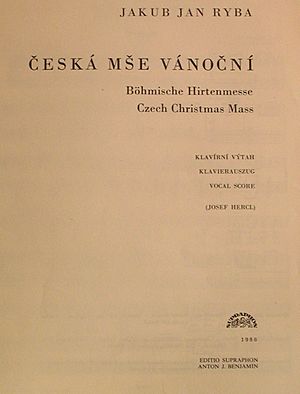Czech Christmas Mass facts for kids
Quick facts for kids Česká mše vánoční |
|
|---|---|
| Pastoral mass by Jakub Jan Ryba | |

Title page of a piano reduction
|
|
| English | Czech Christmas Mass |
| Full title | Missa solemnis Festis Nativitatis D. J. Ch. accommodata in linguam bohemicam musikamque redacta – que redacta per Jac. Joa. Ryba |
| Language | Czech |
| Composed | 1796 |
| Movements | 9 |
| Scoring |
|
The Czech Christmas Mass (in Czech: Česká mše vánoční) is a very popular piece of music. It was written by a Czech composer named Jakub Jan Ryba in 1796. Even though it's called a "mass," it's more like a musical story. It tells about the birth of Jesus in a way that feels like a Czech village Christmas.
This special music uses characters and sounds that remind people of the Czech countryside. It has become a huge part of Christmas celebrations for Czech people everywhere. Sometimes, it's also known as Hail, Master! or Hey, Master! (in Czech: Hej, mistře!) because of its famous opening words.
About This Famous Music
Ryba created his most well-known work in 1796. He wrote both the music and the Czech words for it himself. This was his only "mass" that used only Czech words. Sadly, the original handwritten music for this piece is now lost. Only the title page still exists today.
Ryba wrote over 1,000 musical pieces during his life. But the Czech Christmas Mass is one of the very few that people still perform regularly. In 2007, an animated film called Česká mše vánoční was made. It featured Ryba's music and art by the famous Czech painter Josef Lada.
How the Music is Put Together
The Czech Christmas Mass was originally written in the key of A major. But today, it is most often played in G major, which is a bit lower. The music has a main form called ordinarium, which means it follows a traditional structure. It is made up of nine different parts.
This music has short, catchy tunes that sound like folk music. It also uses lively rhythms. Many people think of it as a Christmas cantata. A cantata is a piece of music for singers and instruments. It often tells a story. Because of its simple, folk-like style, it is not usually played during Catholic church services. However, it is still very much connected to traditional Czech Christmas celebrations.
The famous Czech singer Magdalena Kožená remembers that this music was often performed in local churches on Christmas Eve when she was growing up.
Here are the nine parts of the mass:
- Kyrie: This first part starts with the well-known words, "Hej, mistře, vstaň bystře!" ("Hey Master, get up quickly!"). A young shepherd wakes his master. They both wonder about strange things happening in nature.
- Gloria: This part is a joyful song celebrating the birth of Christ.
- Graduale: Shepherds gather people from all over the land. This section ends with an invitation: "K Betlému teď půjdeme, Boha slavit budeme." ("We're going to Bethlehem, to celebrate God.")
- Credo: In the Czech Christmas Mass, this part describes how people get ready for their journey to Bethlehem.
- Offertorium: This section shows people gathering around the manger. They offer musical gifts to God and Christ.
- Sanctus: This is the shortest part of the music. It is like an angelic hymn.
- Benedictus: This part features a solo soprano singer. It celebrates the newborn Redeemer.
- Agnus: This section is about saying goodbye to Christ. It also includes a prayer for the protection of all people.
- Communio: The final part ends with a grand song sung by a choir. It celebrates the Holy Trinity.
The original music was written for four solo singers, a choir, and an organ. It also included instruments like a flute, two clarinets, two horns, a trumpet, two violins, a viola, a double bass, and timpani.
Images for kids



